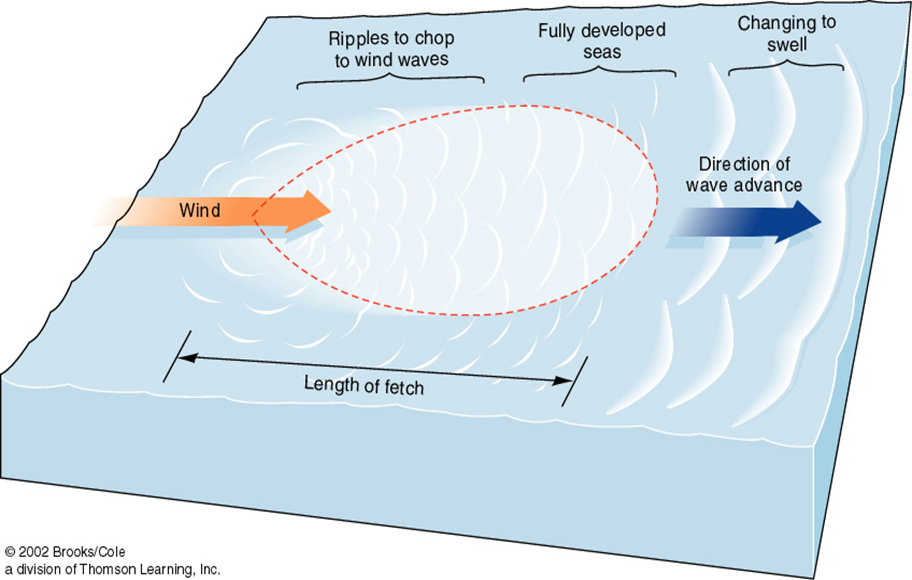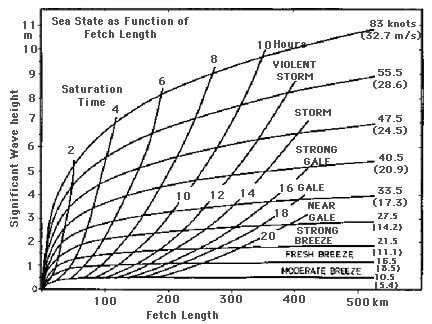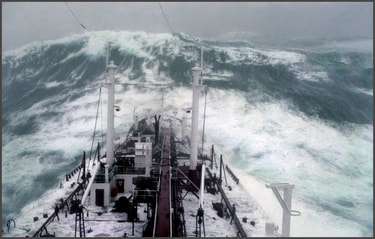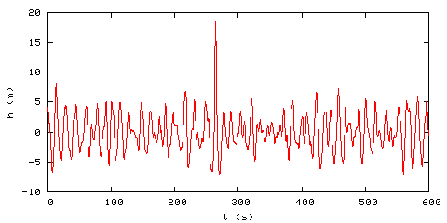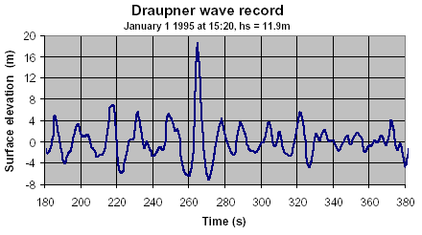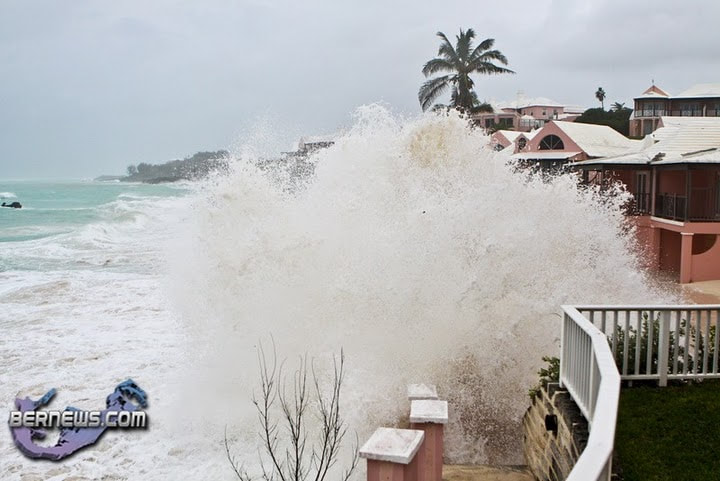|
Beaches >>
|
4.2 - Formation of Waves
Objectives:
- Know that wind causes waves.
- Understand that wave height depends on wind speed, duration and fetch.
- To understand the formation of a breaking wave crest.
- To know what is meant by a fully developed sea and significant wave height.
- To understand the difference between waves and swell.
Waves are generally caused by the action of the wind blowing across the surface of the sea. They can also be caused by seismic activity, tides and the passage of ships, which will be covered later. In the long term absence of wind, the sea will be glassy and smooth - calm. When wind blows across it the sea causes friction on the lower layer of the wind. Think of any two surfaces rubbing together. In turn, this frictional force acts on the surface layer of the sea due to Newton's Third Law of Motion. This has the effect of creating a disturbance - waves. The size of these waves is dependent on a number of variables:
Wind Speed
The greater the wind speed, the bigger the forces acting on the sea and so the waves get larger! Living on an island in the ocean we have all seen the difference in the waves on a stormy day to that of a calm day. **** add wind stress ***
Duration
Water is far denser than air, so has more inertia. It takes time for the wind to fully build up these waves. The longer the storm blows, the larger the waves will become. Offshore sailors are not generally worried about the wind, but they are all concerned about the waves. Of course, wind creates the waves! However, a sudden build up of wind can create the fast sailing conditions of plenty of power in the sails and flat(ish) seas.
Fetch
This is the distance over the water that is affected by the wind and waves. Strong winds blowing over a small lake does not produce big waves. If the distance that the wave can travel is long, then the waves steadily get bigger and bigger. This can be observed on a stormy day in Hamilton Harbour, which is open to the west. If the wind is blowing hard from the north, south or east, the waves are pretty small and benign. However, if the wind blows from the west or southwest, they can get pretty large and damaging. It is rarely just the wind that breaks a boat from its mooring during a storm, but the violent motion due to the waves that puts stress on the gear. This is what defines a good harbour - an open location that you can sail a ship into that limits the fetch to a safe level. One of the best natural harbours in the world is Sydney Harbour in Australia. Have a look on a chart or map and see what makes it such a great location. The Atlantic Ocean is a classic example of a long fetch. The Trade Winds blowing off Africa produce ever larger seas as you sail west towards the Caribbean. For storm force winds, the fetch required to produce truly horrific waves is about 500 - 700 km.
- Wind speed
- Duration
- Fetch
Wind Speed
The greater the wind speed, the bigger the forces acting on the sea and so the waves get larger! Living on an island in the ocean we have all seen the difference in the waves on a stormy day to that of a calm day. **** add wind stress ***
Duration
Water is far denser than air, so has more inertia. It takes time for the wind to fully build up these waves. The longer the storm blows, the larger the waves will become. Offshore sailors are not generally worried about the wind, but they are all concerned about the waves. Of course, wind creates the waves! However, a sudden build up of wind can create the fast sailing conditions of plenty of power in the sails and flat(ish) seas.
Fetch
This is the distance over the water that is affected by the wind and waves. Strong winds blowing over a small lake does not produce big waves. If the distance that the wave can travel is long, then the waves steadily get bigger and bigger. This can be observed on a stormy day in Hamilton Harbour, which is open to the west. If the wind is blowing hard from the north, south or east, the waves are pretty small and benign. However, if the wind blows from the west or southwest, they can get pretty large and damaging. It is rarely just the wind that breaks a boat from its mooring during a storm, but the violent motion due to the waves that puts stress on the gear. This is what defines a good harbour - an open location that you can sail a ship into that limits the fetch to a safe level. One of the best natural harbours in the world is Sydney Harbour in Australia. Have a look on a chart or map and see what makes it such a great location. The Atlantic Ocean is a classic example of a long fetch. The Trade Winds blowing off Africa produce ever larger seas as you sail west towards the Caribbean. For storm force winds, the fetch required to produce truly horrific waves is about 500 - 700 km.
The larger the waves are, the more the energy they have. Try standing up to your ankles in fast moving water. It can be a bit tricky. If the water was say up to your knees it is impossible to stand still any longer. Another example of the energy and power of waves is swimming in the surf off Horseshoe Bay in relatively small waves! Walking along the beaches of Bermuda after a big storm also highlights the mighty forces that the waves can produce.
Sizes of Waves
In light winds, the waves are small RIPPLES and look like the waves we see in physics textbooks. Their wavelengths and wave heights are small and gentle. As the wind increases the waves change away from the pure sinusoidal wave to a longer, higher and more pointed topped wave with the crests being blown off. This is called CHOP. The white foamy crests are known as white caps if small. As a guide, the white caps usually form when the breeze reaches 12 kts. As the wind builds up the white caps become more pronounced and common. Once the tops of the waves are being blown off to a large degree, a SEA has formed the foamy crests become known as white horses. These foamy crests provide almost no buoyancy. STORM WAVES are scary and very large, with the leeward side occasionally becoming concave. This can be extremely dangerous for shipping.
A FULLY DEVELOPED SEA is the term given when the combination of fetch, wind and duration have produced their waves of a maximum average height and period. An old sailor's legend is that "every seventh one is a big one", although in my experience this is not true! While navigating in waves is scary and hard work, you often see a wave that is a bit larger than the others. Often this is not so much the problem, but it slows the boat enough that the next one wallops you!
Significant Wave Height
As with all things, the wave heights produced on water by the winds are not uniformly the same. Some are larger than others. This makes quantifying waves at sea somewhat difficult. Therefore scientists use the term "significant wave height" to define the average wave height. It is defined as " the mean height of the largest 1/3rd of the waves".
In light winds, the waves are small RIPPLES and look like the waves we see in physics textbooks. Their wavelengths and wave heights are small and gentle. As the wind increases the waves change away from the pure sinusoidal wave to a longer, higher and more pointed topped wave with the crests being blown off. This is called CHOP. The white foamy crests are known as white caps if small. As a guide, the white caps usually form when the breeze reaches 12 kts. As the wind builds up the white caps become more pronounced and common. Once the tops of the waves are being blown off to a large degree, a SEA has formed the foamy crests become known as white horses. These foamy crests provide almost no buoyancy. STORM WAVES are scary and very large, with the leeward side occasionally becoming concave. This can be extremely dangerous for shipping.
A FULLY DEVELOPED SEA is the term given when the combination of fetch, wind and duration have produced their waves of a maximum average height and period. An old sailor's legend is that "every seventh one is a big one", although in my experience this is not true! While navigating in waves is scary and hard work, you often see a wave that is a bit larger than the others. Often this is not so much the problem, but it slows the boat enough that the next one wallops you!
Significant Wave Height
As with all things, the wave heights produced on water by the winds are not uniformly the same. Some are larger than others. This makes quantifying waves at sea somewhat difficult. Therefore scientists use the term "significant wave height" to define the average wave height. It is defined as " the mean height of the largest 1/3rd of the waves".
|
|
OC 4.2 - Wave Formation
Revision video made during the COVID lockdown. Poor sound quality due to terrible laptop mic. May re-record it. |
Swell
Even on a calm day off Bermuda, it is observed that ocean's surface has a long slowish wobble to it. This is an example of SWELL. These are generally long wavelength sinusoidal waves that are the remnants or products of a far away storm system. The direction that the swell has come from points to where the storm once was or is. The wave speed is related to the wave length and the swell are long waves that have travelled a long way. Swell at sea is generally benign in the absence of wind waves - but can be sickening and/or annoying. If is hard to keep a yacht sailing in light winds with a swell running. If there are wind waves, it is possible that they are coming from a different direction as the swell, which can lead to what sailors call a CONFUSED SEA. Not fun. Long wave ocean swells can bring enormous waves when they arrive at a gently shelving beach - surfers love them. A large swell striking the reefs off South Shore in August - October is a pretty sure sign that there is a hurricane coming.
Even on a calm day off Bermuda, it is observed that ocean's surface has a long slowish wobble to it. This is an example of SWELL. These are generally long wavelength sinusoidal waves that are the remnants or products of a far away storm system. The direction that the swell has come from points to where the storm once was or is. The wave speed is related to the wave length and the swell are long waves that have travelled a long way. Swell at sea is generally benign in the absence of wind waves - but can be sickening and/or annoying. If is hard to keep a yacht sailing in light winds with a swell running. If there are wind waves, it is possible that they are coming from a different direction as the swell, which can lead to what sailors call a CONFUSED SEA. Not fun. Long wave ocean swells can bring enormous waves when they arrive at a gently shelving beach - surfers love them. A large swell striking the reefs off South Shore in August - October is a pretty sure sign that there is a hurricane coming.
Wave Interference
If waves from two different sources meet at a point, they can interfere with other. In pure physics terms we can have either constructive or destructive interference. If the crests meet at the same time, they reinforce each other to produce a larger wave. If the crest of one coincides with the trough of another we get a smaller wave. The complication of the real world is that the wavelengths (frequencies) of these waves are almost never the same, and their directions are almost never parallel. This can create a nasty confused sea with the occasional monster waves - called ROGUE WAVES. These were the stuff of legend and rumour - and sea stories as they were never confirmed. Usually as everybody that met one at sea did not live to report it. The two most famous recordings of a rogue wave are from the USS Rampano in 1933 and the Draupner Oil Platform in 1995.
If waves from two different sources meet at a point, they can interfere with other. In pure physics terms we can have either constructive or destructive interference. If the crests meet at the same time, they reinforce each other to produce a larger wave. If the crest of one coincides with the trough of another we get a smaller wave. The complication of the real world is that the wavelengths (frequencies) of these waves are almost never the same, and their directions are almost never parallel. This can create a nasty confused sea with the occasional monster waves - called ROGUE WAVES. These were the stuff of legend and rumour - and sea stories as they were never confirmed. Usually as everybody that met one at sea did not live to report it. The two most famous recordings of a rogue wave are from the USS Rampano in 1933 and the Draupner Oil Platform in 1995.
|
The Draupner Rogue Wave - note the significant wave height of about 12 m and the massive spike of 24.5 m. It is possible to see two waves in this graph, the higher frequency wind waves from the storm and the lower frequency swells. (Images: Wikipedia)
|
| wave_data.xlsx | |
| File Size: | 10 kb |
| File Type: | xlsx |
Beaches >>
